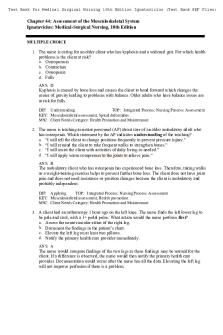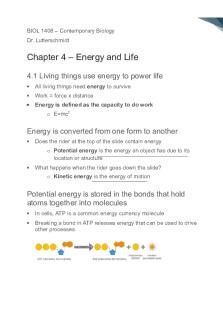Chapter 4.4 Energy PDF

| Title | Chapter 4.4 Energy |
|---|---|
| Course | Introduction to Environmental Sciences |
| Institution | University of the People |
| Pages | 6 |
| File Size | 90.4 KB |
| File Type | |
| Total Downloads | 61 |
| Total Views | 172 |
Summary
Environmental Science Chapter4.4 Summary note...
Description
Chapter 4.4 Summary Notes
Energy Enters Ecosystems through Photosynthesis
All living organisms on earth consist of one or more cells (CK12, 2015a, 2015b). Each cell runs on the chemical energy found mainly in carbohydrate molecules (food), and the majority of these molecules are produced by one process: photosynthesis. Through photosynthesis, certain organisms convert solar energy (sunlight) into chemical energy, which is then used to build carbohydrate molecules. The energy used to hold these molecules together is released when an organism breaks down food. Cells then use this energy to perform work, such as cellular respiration. The energy that is harnessed from photosynthesis enters the ecosystems of our planet continuously and is transferred from one organism to another. Therefore, directly or indirectly, the process of photosynthesis provides most of the energy required by living things on earth. Photosynthesis also results in the release of oxygen into the atmosphere. In short, to eat and breathe, humans depend almost entirely on the organisms that carry out photosynthesis.
Solar Dependence and Food Production Some organisms can carry out photosynthesis, whereas others cannot. An autotrophy is an organism that can produce its own food. The Greek roots of the word autotrophy mean “self” (auto) “feeder” (trophy). Plants are the best-known autotrophy, but others exist, including certain Chapter 4.4 Energy Summary Notes
1
types of bacteria and algae (Figure 4.12). Oceanic algae contribute enormous quantities of food and oxygen to global food chains. Plants are also photoautotrophs, a type of autotrophy that uses sunlight and carbon from carbon dioxide to synthesize chemical energy in the form of carbohydrates. All organisms carrying out photosynthesis require sunlight. Heterotrophy is organisms incapable of photosynthesis that must therefore obtain energy and carbon from food by consuming other organisms. The Greek roots of the word heterotrophy mean “other” (hetero) “feeder” (trophy), meaning that their food comes from other organisms. Even if the food organism is another animal, this food traces its origins back to autotrophy and the process of photosynthesis. Humans are heterotrophy, as are all animals. Heterotrophy depends on autotrophy, either directly or indirectly. Deer and wolves are heterotrophy. A deer obtains energy by eating plants. A wolf eating a deer obtains energy that originally came from the plants eaten by that deer.
Main Structures and Summary of Photosynthesis Photosynthesis requires sunlight, carbon dioxide, and water as starting reactants (Figure4.14). After the process is complete, photosynthesis releases oxygen and produces carbohydrate molecules, most commonly glucose. These sugar molecules contain the energy that living things need to survive. The complex reactions of photosynthesis can be summarized by the chemical equation shown in Figure4.15 Although the equation looks simple, the many steps that take place during photosynthesis are actually quite complex, as in the way that the reaction summarizing cellular respiration represented many individual reactions. In plants, photosynthesis takes place primarily in leaves, which consist of many layers of cells and have differentiated top and bottom Chapter 4.4 Energy Summary Notes
2
sides. Photosynthesis takes place inside an organelle called a chloroplast. Chloroplasts have a double (inner and outer) membrane. Within the chloroplast is a third membrane that forms stacked, disc-shaped structures called thylakoids. Embedded in the thylakoid membrane are molecules of chlorophyll, a pigment (a molecule that absorbs light) through which the entire process of photosynthesis begins.
The Two Parts of Photosynthesis Photosynthesis takes place in two stages: the light-dependent reactions and the Calvin cycle. In the light-dependent reactions chlorophyll absorbs energy from sunlight and then converts it into chemical energy with the use of water. The light-dependent reactions release oxygen from the hydrolysis of water as a byproduct. In the Calvin cycle, the chemical energy derived from the light-dependent reactions drives both the capture of carbon in carbon dioxide molecules and the subsequent assembly of sugar molecules. The two reactions use carrier molecules to transport the energy from one to the other. The carriers that move energy from the light-dependent reactions to the Calvin cycle reactions can be thought of as “full” because they bring energy. After the energy is released, the “empty” energy carriers return to the light-dependent reactions to obtain more energy. Heterotrophy is organisms incapable of photosynthesis that must therefore obtain energy and carbon from food by consuming other organisms. Humans are heterotrophy, as are all animals.
Generating an Energy Carrier: ATP
Chapter 4.4 Energy Summary Notes
3
Photosynthesis begins with the light reactions. It is during these reactions that the energy from sunlight is absorbed by the pigment chlorophyll in the thylakoid membranes of the chloroplast. The energy is then temporarily transferred to two molecules, ATP (adenosine triphosphate) and NADPH (nicotinamide adenine dinucleotide phosphate), which are used in the second stage of photosynthesis. The energy that these molecules carry is stored in a bond that holds a single atom to the molecule. For ATP, it is a phosphate atom, and for NADPH, it is a hydrogen atom. During the light reactions, water is used and oxygen is produced. When these molecules release energy into the Calvin cycle, they each lose atoms to become the lower-energy molecules ADP and NADP+.
The Calvin cycle After the energy from the sun is converted and packaged into ATP and NADPH, the cell has the fuel needed to build food in the form of carbohydrate molecules. The carbohydrate molecules made will have a backbone of carbon atoms. The carbon atoms used to build carbohydrate molecules comes from carbon dioxide, the gas that animals exhale with each breath. The Calvin cycle is the term used for the reactions of photosynthesis that use the energy stored by the light dependent reactions to form glucose and other carbohydrate molecules. In plants, carbon dioxide (CO2) enters the chloroplast through the stomata and diffuses into the stoma of the chloroplast— the site of the Calvin cycle reactions where sugar is synthesized. The reactions are named after the scientist who discovered them, and reference the fact that the reactions function as a cycle.
The Energy Cycle Chapter 4.4 Energy Summary Notes
4
Living things access energy by breaking down carbohydrate molecules. However, if plants make carbohydrate molecules, why would they need to break them down? Carbohydrates are storage molecules for energy in all living things. Although energy can be stored in molecules like ATP, carbohydrates are much more stable and efficient reservoirs for chemical energy. Photosynthetic organisms also carry out the reactions of respiration to harvest the energy that they have stored in carbohydrates, for example, plants have mitochondria in addition to chloroplasts. You may have noticed that the overall reaction for photosynthesis 6CO2 + 6H2O → C6H12O6 + 6O2 Is the reverse of the overall reaction for cellular respiration? 6O2 + C6H12O6 → 6CO2 + 6H2O Photosynthesis produces oxygen as a byproduct, and respiration produces carbon dioxide as a byproduct. In nature, there is no such thing as waste. Every single atom of matter is conserved, recycling indefinitely. Substances change form or move from one type of molecule to another, but never disappear. CO2 is no more a form of waste produced by respiration than oxygen is a waste product of photosynthesis. Both are byproducts of reactions that move on to other reactions. Photosynthesis absorbs energy to build carbohydrates in chloroplasts, and aerobic cellular respiration releases energy by using oxygen to break down carbohydrates. Photosynthesis and cellular respiration function in a biological cycle, allowing organisms to access life-sustaining energy that originates millions of miles away in a star.
Chapter 4.4 Energy Summary Notes
5
Chapter 4.4 Energy Summary Notes
6...
Similar Free PDFs

Chapter 44 notes
- 5 Pages

Quizlet Chapter 44
- 2 Pages

Chapter 44 - Practice questions
- 14 Pages

Chapter 44 - Legal Accountability
- 13 Pages

Chapter 44 - operating segments
- 17 Pages

Module 44 - Lecture notes 44
- 3 Pages

Chapter 4.4 Energy
- 6 Pages

Energy Chapter Quiz Answers
- 2 Pages

Page 44
- 1 Pages

Assignment 44
- 1 Pages

Chapter 3 Matter and Energy
- 5 Pages

Chapter 44 HW Responses Haz MAT
- 6 Pages

Energy
- 5 Pages

Chapter 4 - Energy and LIfe
- 14 Pages
Popular Institutions
- Tinajero National High School - Annex
- Politeknik Caltex Riau
- Yokohama City University
- SGT University
- University of Al-Qadisiyah
- Divine Word College of Vigan
- Techniek College Rotterdam
- Universidade de Santiago
- Universiti Teknologi MARA Cawangan Johor Kampus Pasir Gudang
- Poltekkes Kemenkes Yogyakarta
- Baguio City National High School
- Colegio san marcos
- preparatoria uno
- Centro de Bachillerato Tecnológico Industrial y de Servicios No. 107
- Dalian Maritime University
- Quang Trung Secondary School
- Colegio Tecnológico en Informática
- Corporación Regional de Educación Superior
- Grupo CEDVA
- Dar Al Uloom University
- Centro de Estudios Preuniversitarios de la Universidad Nacional de Ingeniería
- 上智大学
- Aakash International School, Nuna Majara
- San Felipe Neri Catholic School
- Kang Chiao International School - New Taipei City
- Misamis Occidental National High School
- Institución Educativa Escuela Normal Juan Ladrilleros
- Kolehiyo ng Pantukan
- Batanes State College
- Instituto Continental
- Sekolah Menengah Kejuruan Kesehatan Kaltara (Tarakan)
- Colegio de La Inmaculada Concepcion - Cebu

